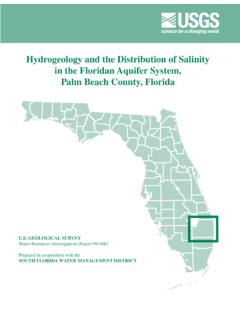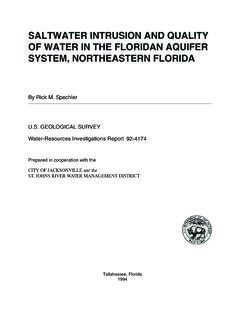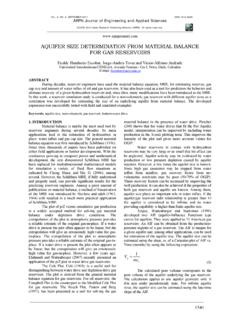Transcription of SOLE SOURCE AQUIFER PETITION - US EPA
1 SOLE SOURCE AQUIFER PETITION MICHINDOH GLACIAL AQUIFER Prepared and Submitted for: City of Bryan, Ohio October 2007 Phone: (574) 675-4900 Website: Tritium, Inc. Page i October 5, 2007 TABLE OF CONTENTS TABLE OF CONTENTS .. i FIGURES .. iii TABLES .. iv 1 Petitioner 1 Narrative .. 2 REGIONAL 4 Bedrock Geology .. 4 Regional Structures ..4 Marshall Coldwater Shale (Cuyahoga Shale, Ohio)..6 Undivided Antrim Shale (Ohio Shale, Ohio)..6 Traverse Dundee Detroit River Quaternary Geology .. 7 Modern Alluvial Glacial Sediments ..8 Soils .. 9 MICHINDOH GLACIAL AQUIFER SYSTEM .. 10 Physical Description .. 10 AQUIFER Boundaries ..10 Hydraulic Groundwater Discharge and Withdrawal ..13 Recharge Areas .. 15 Recharge Delineation Methods and Results.
2 16 Recharge SOURCE Description ..17 Vulnerability Assessment .. 17 Streamflow SOURCE Area .. 20 SOURCE Area Delineation ..20 Gaining/Losing Rivers ..21 AQUIFER Service Area .. 22 Project Review Area (Designated Area).. 23 Physical Extent Boundary ..23 Groundwater Divide Economic Boundary ..23 Surface Water Drainage Basins ..24 SOLE (PRINCIPAL) SOURCE DETERMINATION .. 25 Population .. 25 Total Population ..25 Total Population Served ..26 Current Drinking Water 26 SOURCE Matrix ..27 SOURCE Narratives ..28 Explanation of Variations ..29 Current Demand and Potential Withdrawal ..29 Alternative Drinking Water 29 Alternative SOURCE Tritium, Inc. Page ii October 5, 2007 Political ECONOMIC FEASIBILITY.
3 33 Purchased Water .. 35 New 36 Surface Water .. 36 Pump Stations ..37 Water Treatment Up-Ground (Off-Channel) Stilling Other Project Costs ..40 Annual Costs ..40 Alternate SOURCE Selection ..41 Available Funding .. 43 Economic Analyses .. 46 Municipal PWSS ..46 Rural Distribution CONCLUSIONS .. 50 REFERENCES .. 54 Tritium, Inc. Page iii October 5, 2007 FIGURES Figure 1 PETITION Study Area Figure 2 Bedrock Geology Figure 3 Generalized Bedrock Stratigraphy Figure 4 Quaternary Geology Figure 5 STATSGO Soil Map Figure 6 Geologic Cross section Locations Figure 7 Cross section A-A Figure 8 Cross section B-B Figure 9 Cross section C-C Figure 10 Cross section D-D Figure 11 Current Municipal Drinking Water Sources Figure 12 Potentiometric Surface Contours Figure 13 Groundwater Recharge Zones Figure 14 River Basins Figure 15 MICHINDOH Boundaries Figure 16 Proposed Sole SOURCE AQUIFER Area Figure 17 United States Population Growth/Decline Figure 18 Traditional Surface Water Treatment Process Sequence (in text page 36)
4 Figure 19 Proposed Alternative Water Supply SOURCE Systems Tritium, Inc. Page iv October 5, 2007 TABLES Table 1. Petitioner Identification Information .. 2 Table 2. Population, Water Demands, and SOURCE Table 3. Groundwater Levels within Permanent Monitoring Wells ..22 Table 4. Rural Population by Table 5. Population by Municipality and State ..27 Table 6. Current Municipal Drinking Water Table 7. Unit Transmission Pipeline Costs ..36 Table 8. Surface Water Treatment Plant Cost Table 9. Clearwell Cost Estimates ..39 Table 10. Reservoir Cost Estimates ..39 Table 11. Municipal Water Demands and Alternative Table 12. Estimated Alternative SOURCE Transfer Costs ..43 Table 13. Available Funding by Municipality ..45 Table 14. Economic Feasibility Analysis Results ..48 APPENDICES APPENDIX A STATSGO SOIL DESCRIPTIONS APPENDIX B STREAM GAUGE DATA APPENDIX C GROUNDWATER LEVEL DATA APPENDIX D PROJECT DESIGN AND ESTIMATED PROJECT COSTS APPENDIX E USGS RASA STUDY - MIDWESTERN BASINS AND ARCHES APPENDIX F RESOLUTIONS AND LETTERS OF SUPPORT Tritium, Inc.
5 Page 1 October 5, 2007 INTRODUCTION The purpose of a sole SOURCE AQUIFER designation is the protection and management of a vulnerable AQUIFER system that represents the sole SOURCE of drinking water within the designated area. The goal of this PETITION is to present the factual, defendable information necessary to justify a sole SOURCE AQUIFER designation for a portion of the MICHINDOH Glacial AQUIFER system. The study area for this PETITION includes portions of nine counties which are contained within three states (Figure 1). The MICHINDOH AQUIFER system is comprised of variably confined, hydraulically-connected, discontinuous sand and gravel intervals distributed vertically within unconsolidated glacial sediments. The research conducted as part of this PETITION includes: 1.
6 A physical description of the AQUIFER and the local boundaries; 2. identification of alternative drinking water sources; 3. population, income, and water demand statistics within the designated area; 4. feasibility analyses of alternative SOURCE implementation design and costs. PETITIONER INFORMATION The Bryan Municipal Utilities, with the approval of the Bryan Board of Public Affairs, on behalf of the City of Bryan, Ohio, has elected to PETITION the Environmental Protection Agency ( EPA) for a Sole SOURCE AQUIFER designation for a portion of the MICHINDOH Glacial AQUIFER . The City of Bryan is located 15 miles south of the Michigan state border and 12 miles east of the Indiana state border in Pulaski Township, Williams County, Ohio. The AQUIFER system is present across nearly all the nine-county, tri-state area presented in Figure 1. The PETITION has been prepared in accordance with Section 1424(e) of the Safe Drinking Water Act of 1974 (Public Law 93-523, 42 300 et.)
7 Seq.), and following the EPA Sole SOURCE AQUIFER Designation Petitioner Guidance document (Document 440/6-87-003). Table 1 contains the Petitioner Identification Information suggested in Exhibit 3-6 of the guidance document. Tritium, Inc. Page 2 October 5, 2007 Table 1. Petitioner Identification Information AQUIFER Name MICHINDOH Glacial AQUIFER Location Northeast Indiana, Southeast Michigan, Northwest Ohio Petitioner Name Bryan Municipal Utilities Address 841 East Edgerton Street City, State, Zip Bryan, Ohio 43506-1413 Phone Number (419) 633-6100 Responsible Person Name Stephen Casebere (Director of Utilities) Phone Number (419)
8 633-6101 Contact Name Norm Echler (Water Superintendent) Name Lou Pendleton (Director of Public Relations) NARRATIVE The MICHINDOH AQUIFER system is an extensive sand and gravel AQUIFER system that covers nearly all the nine-county, three-state study area for this PETITION . The AQUIFER system is comprised of hydraulically-connected sand and gravel intervals distributed laterally and vertically through the nearly 200-foot thick Quaternary sediments that blanket the study area. The AQUIFER system likely extends further west and north than this study area, but the relevant groundwater basin identified within this AQUIFER system is contained within this nine-county area.
9 The MICHINDOH AQUIFER system groundwater quality is generally good. The groundwater contains elevated levels of hardness and iron across the area, similar to the groundwater resources within the Quaternary deposits across the Midwest. Scattered areas also exhibit high concentrations of sulfur and brine, but such areas are not typical in the region. The existing municipalities, residents, and businesses within the nine-county area rely primarily on two water resources to meet the drinking water demands. All of the communities utilize the MICHINDOH AQUIFER system where it is present. The secondary water sources are the three major river systems in the area. The Maumee River is the largest of the three. The St. Joseph River and the Tiffin River represent the other two major river systems, and both are tributaries of the Maumee. Other notable public water supplies that are present adjacent to the proposed SSA area include the municipalities of Angola, Auburn, Fort Wayne, and Garrett in Indiana; Hillsdale and Reading in Michigan; and Archbold, Defiance, and Wauseon in Ohio.
10 The three Ohio communities all rely on surface water resources. The Indiana and Michigan communities rely on groundwater resources. Tritium, Inc. Page 3 October 5, 2007 Bryan Municipal Utilities serves one of the most populated areas in the region and meets one of the largest public water supply demands. The Utility relies exclusively on the MICHINDOH AQUIFER system as the SOURCE for its drinking water. Williams County, Ohio, and the City of Bryan are located in a unique geologic area and are geographically isolated from the other significant adjacent municipal supplies in the region. The Board of Public Affairs recognizes the importance and value of their unique drinking water resource. They have elected to be proactive in the protection of the MICHINDOH AQUIFER system out of concern for their drinking water customers and their companion communities which also rely on this unique AQUIFER system.



















